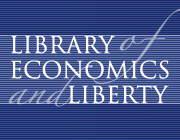
InterestAbout the Author |

The standard procedure for calculating compound interest, under which the interest at the end of each year is added to the principal (the amount borrowed), requires borrowers who want to retain command for two years to repay 106.09 percent of the principal, assuming a 3 percent annual rate of interest. The formula for determining the amount to which the sum to be repaid will grow under compound interest is
where P is the principal, r is the annual interest rate, and n is the number of years for which the principal is borrowed.
Compound interest is an incredibly powerful force. Just how powerful can be seen in the following example. If Thomas Jefferson had invested $10 at 3 percent compound interest to celebrate the signing of the Declaration of Independence, his heirs would have been entitled to almost $3,700 on the day in 1976 when the United States celebrated its two hundredth anniversary. At 6 percent compound interest, Mr. Jefferson's $10 investment would have grown to $1,150,000, or 311 times as much.
An immediate implication is that a quantity of resources available only at a future date has less value today (the present value) than the same quantity of resources available now. The difference in value is determined by the prevailing interest rate. If the annual rate of interest is 3 percent, 100 units of a resource to be received one year from now is equivalent in value to approximately 97.09 units at this time. The formula for determining the present value of future amounts (a process that is called discounting) is derived from the same formula for determining the amount to which present sums will grow in the future:
where F is the future amount and r and n are again the interest rate and the number of years, respectively.
The interest rate enters at least implicitly into all economic decisions, because economic decisions are made by comparing expected future benefits to costs. The only way to make the value of future benefits or costs comparable to one another is to discount them by their "temporal distance" from the present, using the relevant interest rate. The greater this temporal distance (that is, the further into the future the benefit or cost is), the smaller is the discounted, or present, value.
Interest rates quoted by lenders usually include much more than "pure" interest. To persuade a lender to surrender current control of resources, the borrower will have to pay, in addition to interest, an amount that compensates the lender for any costs incurred in arranging the transaction, usually including some kind of insurance premium against the risk of default by the borrower. Someone without an established credit rating who applies for an unsecured loan will typically be required to pay "interest" at an annual rate that is several times the prevailing rate of pure interest.
The interest rate is determined by demand and supply: the demand for present control of resources by those who do not have it, and the supply from those who do have control and are willing to surrender it for a price. The question of exactly why demand and supply yield a positive rate of interest is one of the most fiercely disputed questions in the history of economic theory. It is enough to point out that when an individual acquires present command of resources, his or her set of available opportunities expands. In short, the present command of resources is something that people want. Therefore, those who get it are willing to pay for it, and those who give it up insist that they be compensated for doing so.
The fact that loans are usually made by means of money leads to the mistaken belief that interest is a payment for the use of money. Money is usually what is lent because money offers a general command over resources. But interest also would exist in a pure barter economy where money was not used.
Calling interest "the price of money" mistakenly implies that the interest rate could be brought down by making more money available, in the same way that the price of wheat can be brought down by making more wheat available. This issue could get us into a discussion of monetary theory and policy. It is, however, sufficient to note that increasing the amount of money available tends to lower the purchasing power of money because it causes inflation. In countries that allow their money supplies to grow rapidly, interest rates typically rise because people come to expect inflation. When inflation is anticipated, lenders insist upon being compensated for the expected decline in the value of money over the period of the loan, and borrowers, expecting to make repayment in money of depreciated value, are willing to pay the compensation.
The real interest rate on money loans will be the stated (or nominal) rate minus the anticipated rate of inflation. In countries that are experiencing rapid growth in the amount of money available, interest rates will be very high. But these will be not be high real interest rates. Instead, they will be high nominal interest rates. If expected inflation is 10 percent, for example, and if the real interest rate is 5 percent, the nominal interest rate is 15 percent. But someone who lends money at 15 percent for a year will not be repaid with 15 percent more resources at the end of the year. Rather, the lender will be repaid with 15 percent more money and will be able to use that money to buy only 5 percent more resources.
The real interest rate, by determining the relative value of goods at different times in the future, has important effects on investment decisions. Lower interest rates increase the present value of distant returns, which encourages investors to expand projects that offer the prospect of large returns only at distant dates. Higher interest rates cause investors to concentrate on projects promising earlier returns.
The relationship is one of mutual determination, however. For reasons ranging from the psychological to the technological, people in one society may have a stronger desire for current availability of resources than people in another society. The stronger this desire for instant gratification is, the higher are interest rates.
Paul Heyne was a senior lecturer in economics at the University of Washington in Seattle. He had a Ph.D. in ethics and society from the Divinity School of the University of Chicago. He died in 2000.
Fisher, Irving. The Theory of Interest. 1930. Reprint. 1970.
Patinkin, Don. "Interest." International Encyclopedia of the Social Sciences, vol. 7. 1968.
|
Buyer Beware Consumer Reports
|
|
Cost from Store |
Cost from Builder |
|
| Purchase price | $675 | $450 |
| Finance charge | 110 | 625 |
| Total | 785 | 1,075 |
Consumer Reports goofed. It ignored the present value of money. Because financing charges are paid over time, not all at once, the total cost of both options is actually lower than the totals stated here. Since the builder's option includes interest paid in the distant future, it costs much less than Consumer Reports claims. The builder offers both a lower purchase cost and lower interest rate. Common sense would lead you to choose the builder's deal. Borrowing long-term at low interest rates can be good for your bank account. The present value of money shows why.
John Taylor on Monetary Policy EconTalk podcast, Aug. 18, 2008. How does the Fed control some interest rates?
The Theory of Interest, by Irving Fisher.

